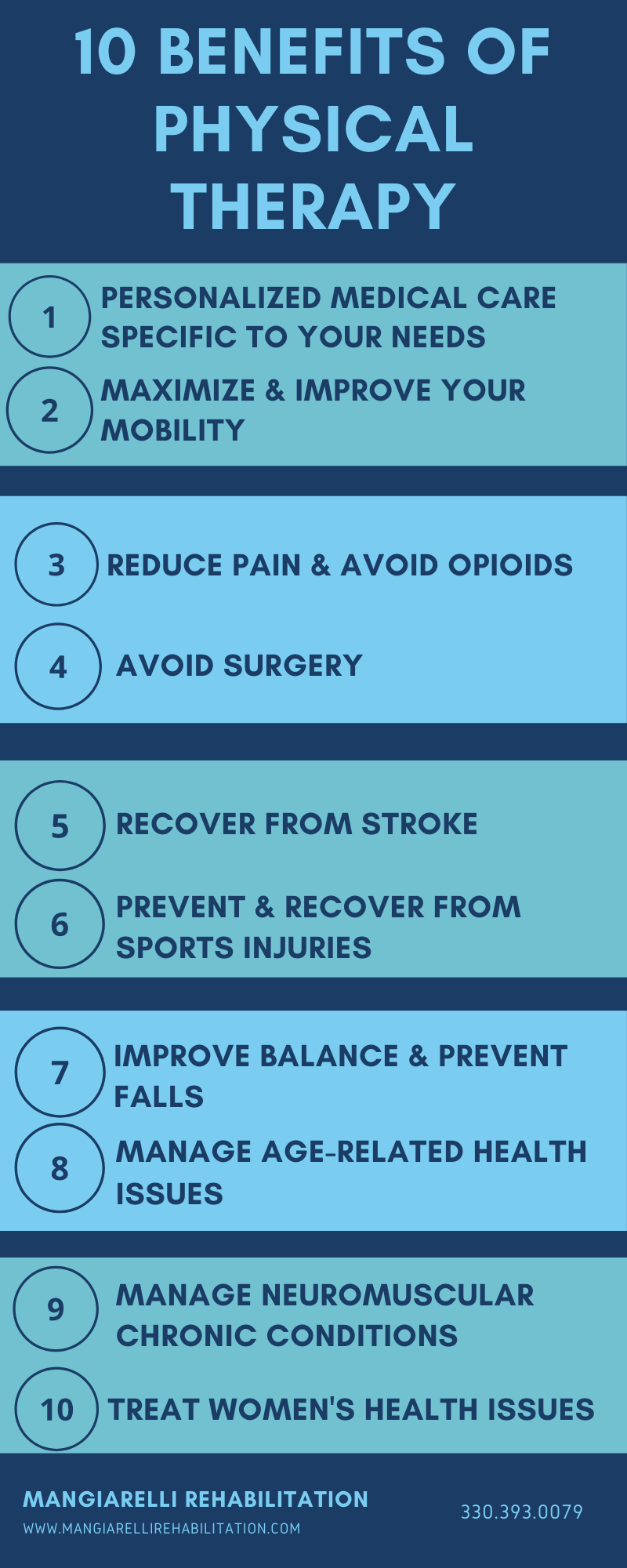10 Benefits of Physical Therapy
In celebration of National Physical Therapy Month this October, we are highlighting 10 benefits of physical therapy. Physical therapy is a field of rehabilitative health that treats musculoskeletal pain, injuries, and limitations through hands-on care, therapeutic exercise, and patient education. Physical therapists are movement experts who are qualified to treat patients of all ages and conditions to improve physical function, mobility, quality of life, and overall health. Physical therapy has high patient satisfaction outcomes while having a low cost on the health care system (compared to traditional diagnostic imaging tests or surgery).
10 Benefits of Physical Therapy
1. Personalized Medical Care Specific to Your Needs: When you come to your first physical therapy appointment, your physical therapist performs a thorough evaluation of your physical function and designs a treatment plan based upon your unique needs, goals, and condition. Physical therapists are skilled practitioners in the science of physical movement and function and will safely and gradually progress you from your baseline state at evaluation to greater strength, flexibility, and mobility by the close of your physical therapy sessions. The physical therapist’s goal is to help you return to your daily activities safely with improved quality of life and greater physical health.
2. Maximize and Improve Your Mobility: If you are struggling to stand, walk, or move with ease, a physical therapist can help you. As experts in movement dysfunction, a physical therapist will identify the underlying issues contributing to your limited mobility and train you in strengthening and stretching exercises to restore your ability to move, stand, and walk pain-free.
3. Reduce Pain and Avoid Opioids: While prescription opioids can be appropriate in certain situations when properly dosed for medical treatment, the ongoing opioid crisis reveals the dangerous side effects and risk of addiction for those who use opioids. In recent years, the CDC has urged the reduction of opioid use and instead utilization of safe alternatives to manage pain, the first of which is physical therapy. Medication masks a patient’s pain without treating the source of the pain. Physical therapy is a safe, non-invasive way to manage pain, particularly chronic pain, that treats the source of a patient’s pain for long-term relief.
4. Avoid Surgery: Prior to undergoing an expensive and invasive surgery, try physical therapy first to address pain and musculoskeletal issues. Physical therapy is as effective as surgery for certain conditions, including knee osteoarthritis, rotator cuff tears, spinal stenosis, and back pain. Should you need to undergo surgery, physical therapy is an excellent preparation for surgery that will help you to recover more quickly as well as a critical element in your post-surgery rehabilitation.
5. Recover from Stroke: A stroke can impact your function, limit your ability to move, and lead to impaired limbs. A physical therapist works with stroke survivors to strengthen weakened areas of the body and improve gait and balance. Physical therapists also help you re-learn daily activities so that you can be as independent as possible post-stroke.
6. Prevent and Recover from Sports Injuries: Physical therapists can help athletes improve endurance, strength, and flexibility before and after injury. Physical therapists are trained to help you safely rehabilitate after a sports injury and follow specific protocols to ensure you return to the sport fully healed. Physical therapists can also design exercise programs for athletes as a preventative measure against injury during the sports season.
7. Improve Balance and Prevent Falls: Physical therapists offer fall risk screens to assess your balance and risk of falling. If you are at high risk of falling, physical therapists work with you to improve your balance through balance training exercises. If your balance issues are due to a vestibular system issue, the therapist will do vestibular rehabilitation therapy with you to address balance issues.
8. Manage age-related health issues: As you get older, you may develop age-related health conditions, such as arthritis, osteoporosis, or joint replacements. Physical therapists are qualified to help you prepare for and recover from joint replacement surgery by strengthening the muscles around that joint and improving your overall quality of movement and function. Therapists design a therapeutic exercise program for patients with osteoporosis, so they can safely engage in weight-bearing activities to build muscle and bone strength. Physical therapists utilize aquatic therapy to help those with arthritis manage pain and build strength, mobility, and balance without stressing sensitive joints.
9. Manage Neuromuscular Chronic Conditions: Neuromuscular disorders like Parkinson’s Disease and Multiple Sclerosis can impact your ability to walk and perform daily activities. Physical therapy plays a key role in helping you manage these conditions and maintain your strength, function, and movement abilities. Multiple sclerosis patients are monitored carefully as they engage in a therapeutic exercise program specifically designed around their needs without exacerbating symptoms. Parkinson’s disease patients engage in training to improve balance, gait, agility, and coordination. At Mangiarelli Rehabilitation, Parkinson’s disease patients can do therapeutic boxing exercise under the supervision of a therapist.
10. Treat Women’s Health issues: Physical therapists can treat a variety of women’s health conditions throughout the course of a woman’s life. Conditions treated include pregnancy-related low back pain, diastasis recti, postpartum care, chronic pelvic pain, pelvic floor dysfunction, painful intercourse, and incontinence.
Physical therapists at Mangiarelli Rehabilitation work closely with doctors and other medical professionals to ensure patients receive holistic, thorough, and appropriate care for their medical condition or injury. Navigating a medical condition or injury can be a challenging and prolonged process. However, our physical therapists ensure you receive the support and care you need throughout the recovery and rehabilitation journey so that you return to daily life safely and stronger than before.
